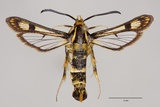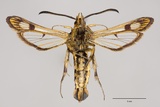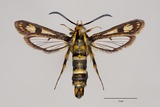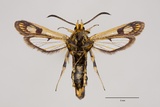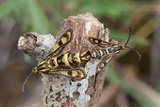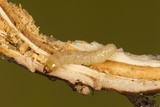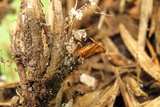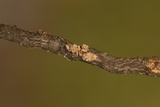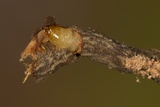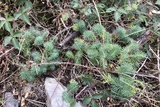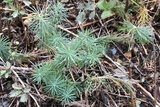Chamaesphecia empiformis (Esper, 1783) Species
Last modified: Sept. 14, 2023, 2:29 p.m.
This species is fairly rare in Belgium and is only known from three provinces in the southern and eastern part of the country. On the other hand, locally, it can be very common in favourable biotopes.
Details
- Classification
- Family: Sesiidae > Subfamily: Sesiinae > Tribus: Synanthedonini > Genus: Chamaesphecia > Species: Chamaesphecia empiformis
- Vernacular names
- Schijn-wolfsmelkwespvlinder (NL), Sésie empiforme (FR), Zypressenwolfsmilch-Glasflügler (DE)
- Synonyms
- Chamaesphecia muscaeformis (Borkhausen, 1789), nec (Esper, 1783)
- First mention in Belgium
- Lambillion L.-J. 1900–1913. Catalogue des Lépidoptères de Belgique. — Revue mensuelle de la Société entomologique namuroise Supplément: 1–464. On page 395.
- Status
-
Native
Distribution
Imago
Ch. empiformis is very variable in size and ranges from 12 mm to 22 mm. It has a golden-yellow appearance and the external transparent area (ETA) on the forewing is usually circular or a bit broader than high and usually consists of 4 cells. There are notable golden-yellow coloured scales between the veins in the apex of the forewing. The brown abdomen has a lot of yellow scales forming diffuse rings that are bordered distally with white on some segments. The anal tuft is black with yellow and is somewhat different in males and females. The proboscis is, as in all species of this genus, well developed and functional.
This species belongs, together with Ch. tenthrediniformis, to a so called cryptic species group. This means these species can not be distinguished from each other based on morphological characters. Examination of the genital structures does not show a useful distinction either but flight behaviour and pheromone response are completely different in both species (see 'Bionomics').
The males are very well attracted to the pheromone originally developed for Bembecia ichneumoniformis and are best lured from noon till late in the afternoon but the optimal time span is very weather dependent.
Genitalia
The genitalia structure is not meaningfully different from that of Ch. tenthrediniformis.
Egg
The glossy black eggs are elliptically shaped and clearly larger than the eggs of Ch. tenthrediniformis, its sibling species.
Mine
The larva mines inside the root of its hostplant, often along the whole length of it and mostly reaching till the root neck. In many cases important parts of the root are stuffed with frass.
Bionomics
Females deposit their eggs mostly both on the upperside and the underside of the leafs of the hostplant. This offers a distinctive difference with Ch. tenthrediniformis where the eggs are laid on the stem at the base of its hostplant. Strong and well developed plants having a root and stalks with a sufficient diameter appear to be preferred although occasionally a larva just fitting inside the root diameter can be encountered. The young larvae initially live in the upper part of the rootstock but gradually construct a gallery towards the tip of the root that can reach a length of several centimetres. Part of this gallery is stuffed with frass and it rarely happens frass is extruded outwards in a visible way. Only if the root is exposed, some frass can be observed. The caterpillar hibernates inside its gallery and, in springtime, resumes feeding and often constructs an exit tube towards ground level. The pupation follows without constructing a cocoon and the adults hatch about 3–4 weeks later. Consequently, this species completes its development in one year.
Besides having a different hostplant, this species also displays other behavioural differences with Ch. tenthrediniformis: the latter is a slow flying and calm species that can easily be observed sitting on its hostplant while Ch. empiformis is a very fast and nervous flier with a very skittish demeanour. Furthermore both species react on a completely different pheromone composition.
Flight periods
The adults fly from early June till mid-August but the main flight period is situated in June and early July and is therefore slightly later than that of his congener Ch. tenthrediniformis.
Observed on
- Host plant (species):
- Euphorbia cyparissias
The caterpillar of this strictly monophagous species bores inside the rootstock of Euphorbia cyparissias.
Habitat
This species prefers dry and xerothermic biotopes such as stony or grassy places, railroad slopes, embankments, roadsides and forest edges.
